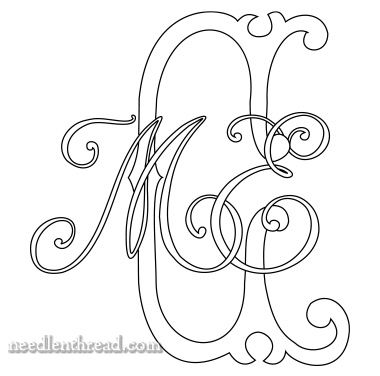The other day, I posted the first three letters of the Delicate Spray monogram alphabet that I’m adding to the hand embroidery patterns here on Needle ‘n Thread.
One of the aspects that I really like about these scrolly-scripty type letters is that they are easy to combine into true monograms – groups of letters – rather than just using them as decorative initials.
Today, let’s look at some ways that individual decorative letters can be combined into groups of letters to form a monogram.

If you’re not an artist – if drawing is just not your thing – that’s ok! You can still create a two or three-initial monograms for hand embroidery out of pre-existing decorative alphabets.
All you’ll need is tracing paper, a pencil and eraser, and the monograms you want to use, printed in the size you want them to be.
The Arrangement of Letters
Traditionally, if a three-letter monogram is meant to represent an individual, the center letter is the initial of the surname (the inherited or last name), the letter on the left is the initial of the first name, and the letter on the right is the initial of the middle name.
If the monogram represents a married couple, traditionally, the central letter is the initial of the husband’s surname, the letter on the left is the initial of the wife’s first name, and the letter on the right is the initial of the husband’s first name.
There are lots of variations to these rules these days, but that’s the simplified, traditional approach to three-letter monograms.
Size of Letters
Often, the central letter in a three-letter monogram (like the C in the monogram above) is a little more dominant than the flanking letters. If you want a more dominant central letter, you’ll need to print that letter larger. It might be significantly larger, or it might just be slightly larger.
The two flanking letters would normally be the same size as each other.
Then, it’s just a matter of tracing the elements you want to include in the monogram design, making sure that the letters are laid out in an arrangement that is pleasing, well-proportioned, and not too cluttered. Start with just the letter forms, making adjustments in your tracing until you are satisfied with the layout.
If you want the letters to intertwine somewhat, follow a logical over-under sequence wherever they overlap.
Once you’re satisfied with the letter layout, then you can add decoration by tracing elements that were on the original decorative letters (like the sprays of flowers in the monogram above), making adjustments as you go until the arrangement is pleasing.
Though the arrangement of the monogram above gives you an idea of the overall three-letter combination, it could still use some work. Back at the drawing table, I’d probably widen up the C a little bit and rearrange the sprays of flowers on the flanking letters.
Embroidering the Monogram
When embroidering the whole group of initials, I’d define the C by stitching it differently from the flanking letters. If, for example, I were to embroider the flanking letters in a smooth satin stitch, I’d perhaps work something more textured on the C.
Or, I might do just the opposite. The C might end up raised and padded, while the flanking letters are worked in something a lighter and more subtle. For example, the flanking letters might just be outlined, while the C is completely filled.
In any case, the central letter in the monogram normally dominates the design, so the embroidery stitches should be chosen to ensure that the design balances around the central letter.
Other Combinations
You can combine other styles of letters into one monogram, too.

For example, you might take the central initial from the more upright Fan Flowers alphabet, eliminating the fans and other decoration, and then use the script style lettering found in the Delicate Spray alphabet for the flanking letters.
As you combine letters, keep in mind your approach to the embroidery.
If you take a look at the monogram directly above, notice how the M and the E are superimposed on the C. This would make it difficult – and probably a little awkward looking – to work the C in a padded stitch. The overlapping M and E would cause too much disruption over the padding.
Instead, on a design like this, you might consider working the C in subtle line stitches and maybe with a light textured filling like seed stitch, and then working the M and the E in a smoother, padded stitch, like satin stitch.
In any case, the point: for those wishing to create more intricate, multi-letter monograms or ciphers for embroidery, you can do so fairly easily by tracing individual letters from pre-existing decorative alphabets and combining the letters in unique ways, to create truly personal monograms.
If you’d like to try your hand at monogramming, you can find several monogram alphabets for hand embroidery available on the Patterns page here on Needle ‘n Thread. Over the next several weeks, I’ll be adding more letters to the Delicate Spray alphabet, which I began sharing with you last week.
